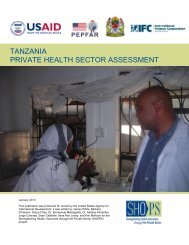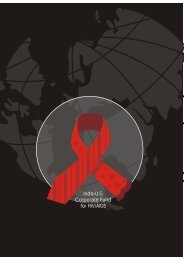Nigeria Private Sector Health Assessment - SHOPS project
Nigeria Private Sector Health Assessment - SHOPS project
Nigeria Private Sector Health Assessment - SHOPS project
You also want an ePaper? Increase the reach of your titles
YUMPU automatically turns print PDFs into web optimized ePapers that Google loves.
3b. Support existing demand-creation strategies and coordinate demand creation with<br />
public- and private-sector supply-side interventions<br />
Whenever possible investments in demand creation should be bundled with investments in<br />
increasing the quality and quantity of contraceptive supplies. According to Mike Egboh, the Pathfinder<br />
representative, there continue to be cases where demand-creation initiatives have lead to frustrated<br />
consumers who cannot obtain contraceptives from either public- or private-sector sources. To prevent<br />
consumer frustrations and to build viable markets for reproductive health providers, increases in<br />
supply must be done in lockstep with demand creation. Therefore any interventions likely to increase<br />
the private sector’s supply of products and services should be done in states where USAID and other<br />
donors are investing in increased knowledge and utilization of reproductive health products and services.<br />
The team recommends continued support and investment in the existing communications strategies<br />
emphasizing maternal morbidity and mortality and birth spacing as a means to address these problems.<br />
Such communications create demand for both public- and private-sector products and services; in<br />
the current market the private sector is unlikely to make such investments. Moreover it is critical to<br />
the development of private-sector markets in reproductive health products and services that these<br />
promising demand-creation strategies be pursued and supported.<br />
There is also the need to avoid missing opportunities to extend existing public-sector programs to<br />
the private sector. <strong>Private</strong>-sector providers need to be systematically brought into provider training<br />
activities that support quality and help build demand. The assessment team found no formal study<br />
assessing the quality of reproductive health services in the private sector, but anecdotal evidence<br />
suggests that many providers (and their clients) could benefit from additional training. The team found,<br />
for example, that at least two private-sector providers shared common myths about IUDs, including<br />
one who said she had been a “victim” of the IUD. <strong>Private</strong>-sector interventions should take advantage of<br />
networks like professional associations and the HMOs accredited under NHIS to expose private-sector<br />
providers to the same levels of training as public sector providers.<br />
Communications also need to create demand among consumers for improved quality in their health<br />
products and services. Low-quality products and services are undercutting quality-assured products<br />
and services, as consumers seem satisfied with lower quality or are unwilling to pay a little more to be<br />
assured of good quality. The public campaign NAFDAC waged is a good first step to encourage demand<br />
for quality goods and services, but more needs to be done. And the message that quality is worth paying<br />
for needs to be extended to the services area as well.<br />
4. Combine increased access to credit with management training for private providers<br />
To address the needs nearly all private providers cited, PSP-One or its partner <strong>project</strong>, Banking on<br />
<strong>Health</strong>, could develop a program that trains providers (such as pharmacists, nurses and midwives, and<br />
physicians) to manage their practices more effectively and help them access credit for establishing or<br />
expanding their businesses. One strategy would be to partner with professional associations in priority<br />
areas for improving reproductive health where lack of access is an issue. This intervention would give<br />
priority to providers working in reproductive health in underserved areas. Alternatively this credit and<br />
management training could become a follow-on to activities 1a and 1b by working through the HMOs<br />
and building on work already begun. In either case this intervention would build on the work done with<br />
the DCA to establish a line of credit with Zenith Bank for small and medium enterprises.<br />
28
















